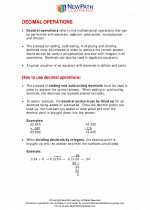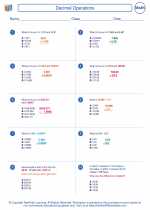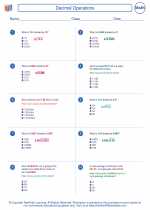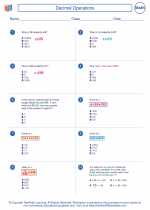Decimal Operations
Introduction
Decimal operations involve performing arithmetic calculations with decimal numbers, including addition, subtraction, multiplication, and division. Understanding how to work with decimal numbers is essential for everyday life and advanced mathematical concepts.Basic Operations
- Addition: When adding decimal numbers, align the decimal points and then add as usual.
- Subtraction: Similar to addition, align the decimal points and subtract as usual.
- Multiplication: Multiply the numbers as if they were whole numbers, and then place the decimal point in the answer based on the total number of decimal places in the original numbers.
- Division: Perform division as if the numbers were whole numbers, then adjust the decimal point in the quotient accordingly.
Study Guide
To master decimal operations, follow these steps:- Understand place value: Recognize the value of each decimal place.
- Addition and Subtraction: Practice aligning decimal points and performing these operations.
- Multiplication: Learn to count the total decimal places in the factors and position the decimal point in the product accordingly.
- Division: Practice long division and learn how to adjust the decimal point in the quotient.
- Real-world problems: Solve word problems involving decimal operations to apply your skills.
with Math Worksheet Generator
◂Math Worksheets and Study Guides Seventh Grade. Decimal Operations
Study Guide Decimal Operations
Decimal Operations  Worksheet/Answer key
Worksheet/Answer key Decimal Operations
Decimal Operations  Worksheet/Answer key
Worksheet/Answer key Decimal Operations
Decimal Operations  Worksheet/Answer key
Worksheet/Answer key Decimal Operations
Decimal Operations 

 Worksheet/Answer key
Worksheet/Answer key
 Worksheet/Answer key
Worksheet/Answer key
 Worksheet/Answer key
Worksheet/Answer key

The resources above cover the following skills:
Number and Operations (NCTM)
Understand numbers, ways of representing numbers, relationships among numbers, and number systems.
Work flexibly with fractions, decimals, and percents to solve problems.
Develop meaning for integers and represent and compare quantities with them.
Understand meanings of operations and how they relate to one another.
Understand the meaning and effects of arithmetic operations with fractions, decimals, and integers.
Compute fluently and make reasonable estimates.
Select appropriate methods and tools for computing with fractions and decimals from among mental computation, estimation, calculators or computers, and paper and pencil, depending on the situation, and apply the selected methods.
Develop and analyze algorithms for computing with fractions, decimals, and integers and develop fluency in their use.
Grade 7 Curriculum Focal Points (NCTM)
Number and Operations and Algebra: Developing an understanding of operations on all rational numbers and solving linear equations
Students extend understandings of addition, subtraction, multiplication, and division, together with their properties, to all rational numbers, including negative integers. By applying properties of arithmetic and considering negative numbers in everyday contexts (e.g., situations of owing money or measuring elevations above and below sea level), students explain why the rules for adding, subtracting, multiplying, and dividing with negative numbers make sense. They use the arithmetic of rational numbers as they formulate and solve linear equations in one variable and use these equations to solve problems. Students make strategic choices of procedures to solve linear equations in one variable and implement them efficiently, understanding that when they use the properties of equality to express an equation in a new way, solutions that they obtain for the new equation also solve the original equation.